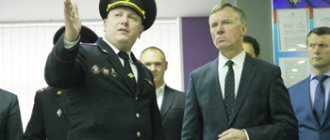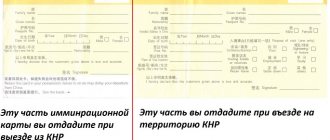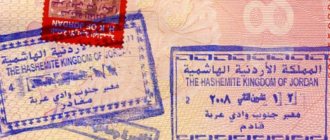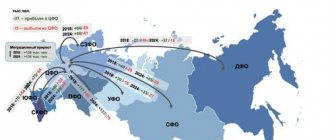What is state migration policy?
Scientific definitions of the term “migration policy” are quite massive and difficult to understand. Therefore, we can paraphrase them and give a shorter and more understandable description of this concept. Migration policy, in essence, is a set of certain government rules and regulations that control the presence and activities of foreign citizens in the country. Each state adheres to its own rules. Migration policy is divided into 2 main types:
- immigration – deals with issues related to the affairs of foreigners entering the country;
- emigration policy - establishes a set of rules for those leaving the country.
Often the term “migration” refers specifically to immigration policy. It would seem, what goals can this or that state pursue by allowing immigrants into its country and providing them with comfortable living conditions? In fact, there are quite a few such goals.
- From an economic point of view, the state may be interested in attracting highly qualified specialists, labor, eminent people, large investors, etc.
- In some countries, it is the constant influx of immigrants that increases the actual population size. A set of rules for the repatriation of the population can be included in the same paragraph.
- The humanitarian component plays an important role in migration policy - some states accept refugees for the purpose of humanitarian assistance.
- The government takes care of its citizens - it allows them to marry foreigners. Therefore, it develops a system of rules according to which the family could subsequently be reunited.
It turns out that immigration policy solves a whole range of government problems. For the entire country as a whole, it is very important to be able to build the right political model on migration issues, because the consequences can be disastrous for the indigenous population and the international status of the state.
Models of migration policy
There are only 4 classical models of migration policy. Each of them has a main concept that conveys its entire essence. To make it as clear as possible, after describing the concept, historical examples of its application in different countries will be given.
Complete exclusion
This model is based on not allowing foreigners into the country at all. The experience of some states that have decided on such a policy has shown that the model of complete exclusion is a utopia and ineffective in the context of globalization.
However, even today there are countries that are considered closed to migrants. All of them make it so difficult for foreigners to enter (and some for citizens to leave abroad) that it is very difficult to get into them even for tourism purposes. These include North Korea, Turkmenistan, Syria, Somalia and Afghanistan. In these countries, migration policy is very strict, and even submitting a full set of documents and successfully passing all checks does not guarantee the right to enter (exit).
Segregation
The concept of this model is to temporarily admit foreigners legally, but not to give them citizenship, social benefits or the right to participate in the life of the country. This is typical for states that need labor, but do not want to accept foreigners on a permanent basis. The ban on family restoration and clearly defined periods of stay play an important role here. The undoubted advantage of this model is a calm atmosphere in society: since immigrants will not have civil rights, native residents will not be concerned about their presence.
This model was used by states that are part of Western Europe: Germany, Belgium, Switzerland. They invited people exclusively to work, without giving them any social security. The workforce was called “guest workers”.
If we consider the effectiveness of the model using the vivid example of Germany, we need to look back to the 60s. It was assumed that migrants would come only to work on a temporary contract, and leave the country at the end of it. After only 10 years, this model turned out to be ineffective - employers began to complain that the constant change of foreign workers costs them a pretty penny (they have to train new people to work again and again, so it was more profitable for them to have permanent employees). As a result, the government made concessions and began giving permanent employees a German residence permit. Receiving such a paper made it possible for immigrants to gain a foothold in the country. From that moment on, foreigners began to populate Germany.
Assimilation
This model is based on providing migrants with a residence permit and a full social package, however, foreigners, in turn, must go through the process of full integration. In short, this means that a visitor should be not much different from a native citizen - have a good knowledge of the language, culture of the country, and also adhere to all state laws and rights. Assimilation, like the segregation model, has a significant advantage - peace in society. However, arriving foreigners who have received a residence permit prefer to accumulate in certain points and create ethnic groups. Of course, these people do not show any desire to integrate, believing that they must preserve their roots even on a foreign land. As a result, assimilation policy leads to the emergence of criminal gangs, the formation of entire districts in cities where separate ethnic groups live, etc. Often attempts to eliminate such groups are regarded as racism.
The essence of the state's migration policy
Migration policy acts as a system of objectively determined goals and objectives that are aimed at developing social relations in such an important and controversial area as migration.
Note 1
Let us note that migration policy is always based on the principles of the constitutional system of the state in which it is organized and implemented.
It must be said that in addition to public relations, the scope of migration policy includes:
- The norms of migration legislation of the country within which migration policy is being implemented;
- State management mechanisms that are implemented directly by the subjects of the migration process. The subjects in this case are individuals, various public organizations, government bodies, whose activities directly or indirectly, but to a certain extent, affect the issues of migration processes.
Finished works on a similar topic
Course work State migration policy 420 ₽ Abstract State migration policy 280 ₽ Test work State migration policy 230 ₽
Receive completed work or specialist advice on your educational project Find out the cost
State management mechanisms within the framework of migration policy are aimed at controlling the movement of the population, resettlement, accommodation and settlement, as well as the adaptation and integration of individuals on the territory of the state as a whole and in its individual regions. It is important to take into account the provision of regions with various stimulating and control factors, which make it possible to control the level of migration, its intensity, as well as foci.
Migration policy is more closely related to the problems of refugees and internally displaced persons. It also targets persons who, due to certain circumstances, are forced to seek political or temporary asylum, labor and other migrants. This makes its connection with the legal status of citizens and foreign citizens, the constitutional and legal basis even closer, almost inextricable.
Note 2
The goal of state policy is to regulate extensive migration flows, as well as to overcome the undesirable, negative consequences that spontaneously developing and uncontrolled migration processes lead to.
Have questions about this topic? Ask a question to the teacher and get an answer in 15 minutes! Ask a Question
Also, specialists in the field of migration policy provide the necessary conditions for the unhindered implementation of the rights and freedoms of migrants, ensuring a tolerant, tolerant and humane attitude towards those persons who, due to circumstances, were forced to seek asylum in the territory of our country.
In addition, migration policy is considered as a subject of regulation by constitutional law. It follows from this that the constitutional and legal foundations of migration policy should include the constitutional principles of migration policy, the constitutional and legal status of its subjects, as well as the fundamentals of legal regulation in the field of migration policy of the state.
Features of Russian migration policy at the present stage
If we consider the entire migration policy as a single system, then we can distinguish its subject (that which directs the action) and the object (that which the action is directed at). It is clear that the object in this case is the migration flow. But the subject of the migration policy of the Russian Federation is the president. It is the head of state who defines the concept. The rest of the government simply implements the concept chosen by the president.
In 2021, V. Putin signed a new concept for the migration policy of the Russian Federation, the provisions of which differ significantly from the previously adopted one. Therefore, starting last year, state migration policy has changed radically. If the provisions of the previous concept were based on ensuring the security of the country's indigenous population, now another goal is set at the forefront - attracting migrants to improve the economic and demographic situation of the state.
In essence, Russia is opening its borders to all people who want not only to live on its territory, to fully integrate into Russian society, to give birth and raise children according to local rules and cultural values, but also to migrants who do not connect their lives with long-term residence in RF. Of course, the latter must comply with a set of rules that ensure the safety of the country's population.
Objectives of the state migration policy of the Russian Federation
Based on the analysis of the provisions of the previous concept of migration policy and the results achieved, the government identifies a number of tasks that must be solved by the new decree.
- Improving all mechanisms that will help attract to the country compatriots living abroad, foreigners who want to undergo the full process of integration in the country, and all those who will in any way contribute to the development of the Russian Federation (this group can include highly qualified specialists in in-demand professions, athletes, big businessmen, etc.).
- Organization of all necessary conditions for high-quality and rapid integration into Russian society. This may include assistance in learning the Russian language (language courses) and the development of special programs.
- Providing special conditions for migration in the field of science and education.
- In the field of internal migration, I will pay special attention to reducing the uneven distribution of the population throughout the country. It has been proven that the largest population concentrations are observed in Moscow, St. Petersburg and the Krasnodar Territory. The task of internal migration policy is to attract residents to other regions.
- Complete eradication of corruption and other violations in the field of migration policy.
- Providing assistance to refugee seekers.
The implementation of many of these tasks will require the allocation of large sums from the state treasury.
Problems of migration policy
So, thanks to the experience gained during the previous concept, Russia has the opportunity to resolve many accumulated problems and patch up holes in migration policy.
The problems that the new concept will help resolve include:
- lack of assistance from the host state in the integration of foreigners;
- ineffective management of migration flows, which does not bring benefits to the country;
- corruption - as the most common phenomenon in relations between an official and a visiting foreigner;
- illegal migration (simplification of the rules for obtaining entry into the country will increase the number of legal immigrants and reduce the number of new illegal immigrants).
The only problem, most likely, will remain the need for personal presence to extend a visa or any other document legalizing your stay in the country. Taking into account the fact that there are not so many authorized departments on the territory of Russia, traveling to obtain documents from some parts of the country will be really long.
Main directions
In connection with the objectives of the new concept, the main directions of migration activity can be identified.
- Simplification of the conditions and procedure for obtaining visa documents, residence permits and even acquiring citizenship.
- Financial investments in special programs to resettle people that the country needs.
- Elimination of all conditions that unreasonably complicate the import of property.
- Organization of social benefits and jobs for foreign citizens.
- In the field of education, the number of places in Russian educational institutions will increase for foreign citizens wishing to study on the territory of the Russian Federation, as well as for foreign teachers wishing to teach here.
- In the field of internal migration, the main focus is to provide better living and working conditions in regions of the country with a small population.
- To reduce the flow of illegal migrants, the system of supervision at entry into the country will be improved, as well as control over the activities of foreigners on its territory.
- To control the decisions of officials and eradicate corruption in the field of migration, administrative procedures will be improved. The main innovation will be the introduction of an electronic form of communication between the recipient of government services and the authorities providing them.
- Competent accommodation of refugees asking the Russian Federation for asylum, as well as high-quality assistance in integration.
These are the main directions provided for by the new presidential decree, which will be in force until 2025. The exact text of the current concept can be read here: https://www.kremlin.ru/events/president/news/58986.
Concept of the state migration policy of the Russian Federation for the period until 2025
The concept of the state migration policy of the Russian Federation for the period until 2025 is a system of views on the content, principles and main directions of the Russian Federation’s activities in the field of migration. The concept defines the goals, principles, objectives, main directions and mechanisms for implementing the state migration policy of the Russian Federation.
The Russian government website lists the officials responsible for the Concept - supervising Deputy Prime Minister Anton Siluanov and Minister of Internal Affairs Vladimir Kolokoltsev.
This Concept has been developed in accordance with:
- with the Constitution of the Russian Federation,
- federal constitutional laws,
- federal laws and other regulatory legal acts of the Russian Federation
- The concept of state national policy of the Russian Federation,
- The concept of demographic policy of the Russian Federation for the period until 2025,
- The concept of long-term socio-economic development of the Russian Federation until 2021,
- National Security Strategy of the Russian Federation until 2020
- with generally accepted principles and norms of international law and the obligations of the Russian Federation arising from international treaties in the field of migration.
For the purposes of this Concept, the following basic concepts are used:
- a) academic mobility - international movements of scientists and teachers for the purpose of carrying out scientific and teaching activities, exchanging experience, presenting research results, as well as for other professional purposes;
- b) temporary migration - international or internal migration that occurs for a certain period of time without changing permanent residence. Temporary migration is carried out for the purpose of work (temporary labor migration), study (educational migration) and the like;
- c) long-term migration - international or internal migration that occurs for a long period (at least one year);
- d) quotas for attracting foreign labor - regulation of the number of foreign workers involved in labor activities on the territory of the Russian Federation;
- e) short-term migration - international or internal migration that occurs for a short period of time (less than one year). Movements for recreational purposes, for treatment or short-term business trips do not qualify as migration;
- f) migration for permanent residence - international or internal migration, which involves a change of permanent residence;
- g) illegal migration - movements to the Russian Federation in violation of the legislation of the Russian Federation regarding the entry, stay (residence) of foreign citizens on the territory of the Russian Federation and (or) their labor activities;
- h) educational (study) migration - migration for the purpose of obtaining or continuing education;
- i) organized attraction of foreign labor (foreign workers) - activities of the state or authorized non-state structures in organizing the movement of foreign workers to the Russian Federation, including the organized recruitment of necessary workers in the country of origin, their pre-departure training, admission and employment legally for pre-allocated workers places;
- j) seasonal labor migration - a type of labor migration of foreign citizens whose work by its nature depends on seasonal conditions and is carried out only during part of the year;
- k) labor migration - temporary migration for the purpose of employment and performance of work (provision of services).
The full text of the Concept can be viewed on the official website.
Migration policy of the European Union
Currently, the European Union, consisting of 28 countries, does not have a common migration policy due to disagreements among the member countries. After the main influx of immigrants applying for refugee status arrived in Europe in 2015, for another couple of years the number of such requests, although decreased, did not dry out. In 2021, the EU continues to struggle with the now unwanted, but increasingly, refugees arriving on its territory from North African, South Asian and Middle Eastern countries.
So, opinions regarding the acceptance of refugees into the EU are diametrically opposed. Some countries believe that accepting refugees is a humanitarian necessity; they are ready to provide special premises for their residence, organize social assistance and benefits, and spend money on their integration into European society. Such altruistic countries include Germany, Italy, Sweden, Holland, and France. Other countries have simply become a kind of passage corridor for migrants on the way to the center of Europe, where they provide the most favorable living conditions. The “passing” states include Greece and Turkey. A number of EU countries initially refused to accept refugees at all: Poland, Hungary, Slovakia. Later they were joined by Austria, which managed to regret its ill-conceived decision to accept refugees. The fact that some EU members accept migrants, while others do not, has provoked a rift between them.
After a crazy influx of refugees, the European Union is taking all possible measures to halt the migration process. Some countries simply erect borders and walls to keep immigrants out. As it turned out, the EU’s “excessive tolerance” towards the problems of other states became the cause of the European crisis, which continues to this day. The indigenous population of European countries is dissatisfied and immigrating to more distant countries that are not affected by the refugee resettlement policy. For example, to the USA, Canada, Australia, China. Some migrants are moving to calmer Hungary.
If we talk about the peculiarities of internal migration processes in the EU, then residents of less prosperous countries of the union try to immigrate to more prosperous ones. For example, Romanians, Bulgarians, Poles, Croats, and Hungarians leave their native countries in large numbers and rush in search of a better life. The ultimate goal of the search is rich European countries: Belgium, the Netherlands, Germany, Great Britain, France. Residents of one EU country are free to travel to another EU country to live and work.
Main types of migration policy in Russia
In order to accurately understand how the actions of migration policy, which is adopted and established on the territory of the Russian Federation, take place, it is important to understand what its varieties exist. It is worth immediately noting that modern migration policy differs significantly from the demographic, economic and social sectors in the Russian Federation.
Today it is possible to determine the following types of migration policies that are established and applied in the country. The classification is based on the definition of population migration:
- Duration. It is important to understand that any citizens of the country have the legal right to leave and enter the country not only temporarily, but also on a permanent basis.
- Reasons for moving. Absolutely any citizens living in the countries of the world can decide to migrate. The most common reasons at the moment are economic reasons. As a rule, this is inflation and unemployment. In addition, the reasons may be military, political, family and many others.
- Directionality. In accordance with the legislation adopted in the country, migration can be external in nature, when citizens leave the country. Accordingly, migration can be internal, allowing you to move across territories within the country.
- Organizations. The migration process can be individual, mass or forced. It happens for several reasons.
Need advice from a teacher in this subject area? Ask a question to the teacher and get an answer in 15 minutes! Ask a Question
Note 2
Modern migration law also makes it possible to provide labor migration with the necessary personnel. A distinctive feature can only be the purpose of a particular move. For example, migration, which is based on labor law, provides the necessary and high-quality conditions for labor relocation and good wages.
Goals, principles and objectives of US migration policy
The United States is a country that has long supported multicultural immigration policies. The USA even began to be called “the country of immigrants.” This is true - more than 20,000,000 people live here with official status, and another 13,000,000 are considered illegal immigrants.
Having come to power, the current American President D. Trump first set about tightening immigration policy and deporting illegal immigrants from the country. As a result, migration policy has undergone significant changes and taken on a new direction in the last couple of years.
Trump wants to reduce the number of immigrants staying in the United States, putting the safety of the indigenous population at the forefront. On the one hand, the president’s position is quite clear - the ethnic groups that emerged as a result of multiculturalism provoked the formation of criminal groups whose main activity is the illegal transportation and distribution of drugs, the organization of terrorist acts, vandalism, etc.
In this regard, Trump is actively promoting his proposals to tighten immigration policies, but not all of them have been adopted by Congress. Most of them are still under consideration. For example, D. Trump proposed to allocate a tidy sum from the state treasury for the construction of a protective wall on the border with Mexico. Since the cost of installing the structure turned out to be high, and the effectiveness was questionable, such a decisive step is still being discussed in the government. To date, the wall has only been built on the most important sections of the border with Mexico.
Another step towards ridding America of illegal immigrants is the suppression of the DACA program, adopted by Obama. Its essence is to provide the opportunity for children of illegal immigrants to live in the United States, and it does not give them the right to obtain citizenship, but simply provides protection from deportation. The document legalizing stay is a card that must be renewed periodically. President Trump plans to cancel the renewal of such cards, as a result of which their holders will lose protection from deportation and, accordingly, may be expelled from the country.
The third step against illegal immigrants will be the elimination of the so-called sanctuary cities where ethnic groups and illegal immigrants live. The activities of local residents are not controlled by generally recognized federal law, but by local acts. Now the government plans to stop funding such cities.
The second focus of the new US migration policy is to attract investors and other people to the country who will make a significant contribution to American life. Now highly qualified specialists, wealthy businessmen and investors, people with special achievements in the field of science, culture, sports, etc. will be happy to receive here. Candidates who do not speak the language, who do not want to merge with the national culture, and without higher education, are now unlikely to be able to become residents of America.
To get rid of legal but “unnecessary” migrants, Trump plans to take several measures in the field of migration policy:
- sharply reduce the number of places provided to refugees;
- stop the possibility of indigenous residents inviting all kinds of relatives and leave such a privilege only for spouses and children;
- cancel the world-famous Green Card lottery, which has been randomly determining the lucky holders of a residence permit for more than 30 years;
- innovations in US immigration services - expansion of staff and purchase of special equipment for more efficient screening of candidates.
It is still not known whether all points of Trump’s grandiose plan will be implemented, but US migration policy is already rapidly beginning to change from a pluralistic model to an assimilation one with elements of segregation.
State migration policy: essence, types and tools
State migration policy is the purposeful activity of the state to regulate the processes of export and import of labor to or from a given country. State regulation of labor migration is designed to protect the interests of migrant workers, national workers, and should also ensure mutual protection of the interests of the countries themselves - exporters and importers of labor.
State migration policy is divided into two types: emigration and immigration, which have different goals and methods of regulation. Emigration policy includes indirect methods of regulation designed to create a favorable emigration climate, as well as direct methods aimed at regulating the volume and structure of emigration flows.
Indirect methods:
1) foreign exchange and banking policy to encourage foreign currency transfers from abroad; providing benefits for foreign currency deposits (higher interest on deposits compared to domestic deposits, tax exemption for deposits, preferential postal and telegraph rates for foreign currency transfers, etc.); sale of tax-free securities to migrant workers;
2) customs policy providing customs benefits for returning emigrant workers;
3) special emigration programs, additionally accepted in a number of countries.
Direct methods:
1) requirements for subjects of labor migration: intermediary firms, migrant workers;
2) expansionary policy aimed at winning jobs in the markets of foreign countries (encouraging the departure of such specialists whose work abroad will require the export of domestic products);
3) structural policy, the main elements of which may be:
a) limiting the issuance of foreign passports;
b) a ban (direct and indirect) on the departure of certain categories of workers and the introduction of emigration quotas;
c) establishing the terms of compulsory work in the country after completing education at public expense.
State immigration policy is designed to protect the national labor market from the uncontrolled influx of migrants and ensure the rational use of their labor.
In various immigration programs, migrants are classified into three categories:
1) family emigration (spouses, parents, children, brothers and sisters, elderly relatives, bride or groom, etc.); requires the presence of a relative who is a citizen of the country who can provide guarantee;
2) economic emigration; assumes the presence of qualifications, special abilities, and experience in private business activities that may be useful in the economic development of the country;
a) private entrepreneurial emigration (there is experience and intentions to found an enterprise, as well as sufficient capital for this);
b) emigration of young people with good education and qualifications, as well as the ability to find work;
c) emigration upon invitation to work by an employer;
d) emigration of persons who have achieved great success of international significance in the fields of creativity, sports, etc.;
3) humanitarian emigration; involves recognition of refugee status, etc.
There are three main types of immigration policies that can be applied simultaneously depending on the categories of migrants:
1) based on limiting the stay of immigrants in the country (in terms of number and duration);
2) allowing residence for an indefinite period with the right of entry for family members;
3) allowing permanent residence of immigrants and presupposing the right to obtain citizenship.
Immigration policy is formed from the following instruments:
1. Qualitative requirements for foreign labor:
a) availability of a certificate of education;
b) work experience in the specialty.
2. Age limit.
3. State of health.
4. Personal restrictions (so-called social cleansing).
5. Direct quotas on labor imports.
6. Financial constraints.
7. Time limits.
8 Prohibitions in explicit form, expressed in the adoption of laws containing a detailed list of professions that foreigners are prohibited from engaging in, and indirect form, when a list of priority professions for entry is determined.
9. National geographic priorities.
10. A system of sanctions in relation to illegal migrant workers, persons engaged in illegal import of labor, employers illegally using migrant workers. This includes imprisonment or a fine.
11. Repatriation programs designed to stimulate the outflow of migrant workers. Typically, three types of programs are used:
1) material compensation programs provide cash payments to immigrants for the premature termination of their activities;
2) vocational training programs to make it easier for immigrants to return home and find employment at home;
3) programs of economic assistance to regions of mass emigration.
In general, each country develops its own measures to regulate the inflow and outflow of labor, depending on the internal economic situation of the country. Moreover, a characteristic feature of the regulation of migration processes is that priorities in this area are given to national states. It is the national migration legislation that is decisive in resolving controversial situations.
State migration policy
Back in 2012, the President of Russia approved the Concept, which establishes and defines the necessary migration goals and objectives. In accordance with the document, the following definitions become the goals:
- Solving specific demographic problems on the territory of the Russian Federation.
- Significant improvement in economic indicators. Attracting highly qualified personnel.
- National security of foreign citizens and residents of the Russian Federation.
— — Do you need help creating a study plan? — Specify a topic and receive a response in 15 minutes — — — — — — get help — —
Types of migration policies
There are several types of government policies regarding migration.
Complete exclusion
Migration policy is aimed at keeping the country closed. Experience has shown that such a model is ineffective in the conditions of modern globalization of world processes.
In a number of countries, migration policies are very strict; paperwork does not guarantee entry permission. Such states include Afghanistan, North Korea, Cuba, Nepal, Somalia, and Turkmenistan.
Segregation
This model is typical for states that need additional labor resources. Migrants come to the country on a temporary work contract and leave when it ends. They do not receive citizenship, social benefits, or have the right to vote. Established periods of stay and the absence of civil rights for migrants contribute to a stable situation in the state.
But this model also turned out to be ineffective. Employers bore the costs associated with the constant change of foreign workers - primarily the costs of training and gaining work experience. In some countries, the government made concessions and permanent workers began to receive residence permits.
Political assimilation
Receiving states create favorable conditions for migrants to quickly obtain new citizenship. In this model, the identity of new citizens is determined by the national political structure of the host country, rather than by ethnic and religious origin.
The state does not formally recognize ethnic differences and does not take them into account in its policies. The migrant is required to have a good knowledge of the language and culture of the host country, and adherence to state laws and rights.
This policy is also ineffective. Ignoring the problems of migrants has led to their radicalization, the formation of entire districts in cities with ethnic groups, and the emergence of criminal gangs. Attempts to eliminate such groups are regarded as racism.
Multiculturalism
The model is based on the principle of accepting immigrants while preserving their culture and identity. Visitors enjoy all the rights of the indigenous population and adopt only basic cultural values.
This model implies acceptance not only of the migrant himself, but also of his family. Children born to foreigners who have received citizenship become citizens of the country. This policy causes great public outcry and discontent among the indigenous population.
Social integration and cultural and linguistic adaptation
This is a modern model of integration policy that uses the experience of multiculturalism, but avoids its extremes leading to a split in society.
There are three main components within this model:
- Political and legal – liberalization of the rules for obtaining citizenship and improvement of the legal status of foreigners; anti-discrimination policy (development of legislation, creation of commissions to protect human rights in connection with his ethnicity or membership in other minorities); political integration of migrants (granting voting rights).
- Socio-economic – government programs in the field of employment; adaptation of the education system (language training for migrant workers and members of their families); social programs for adaptation and settlement of forced migrants (housing policy, healthcare, social security).
- Cultural and religious – ensuring migrants the right to cultural autonomy (learning their native language, preserving national traditions).
Many countries are currently transitioning from a policy of multiculturalism to a modern policy of social inclusion. States are searching for the most balanced option that suits the indigenous population and takes into account the needs of migrants:
- solving socio-economic problems, which should eliminate the accumulation of conflict potential in society;
- the introduction of integration measures, for failure to comply with which migrants may face sanctions (this is forced integration on a linguistic, cultural and value basis);
- improving the legal status of migrants, including liberalizing the rules for obtaining citizenship and combating discrimination;
- orientation towards promoting interethnic and interreligious dialogue.








